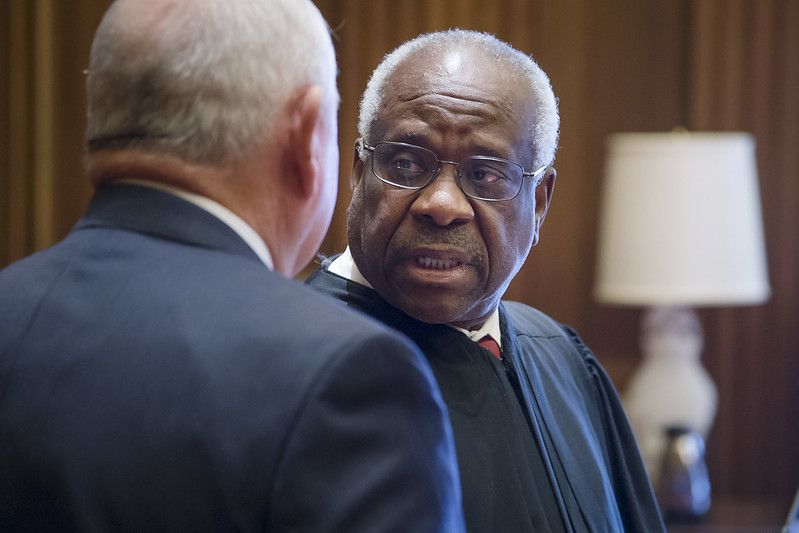
The Constitution was signed on Sep. 17, 1787, and the Ninth Amendment was ratified in 1791—at which time it became the supreme law of the land, like the rest of the Constitution. State judges are bound by it—anything in their states’ constitutions or laws to the contrary notwithstanding.
That’s the law of the land. While the states may exercise legislative authority over the performance of abortions of pre-viable fetuses, they may not disparage—i.e. reduce to little worth—the personal right to abort a pre-viable fetus (or, for that matter, any other personal right not expressly mentioned in the Constitution). Otherwise, the states’ statutory authority would be superior to the Constitution—something the Constitution absolutely prohibits.
Both textualists and originalists on the Supreme Court bench ought to know this. But are they willing to apply the law of the land, as it is, or ignore it, and place their values above it?
Justice Clarence Thomas prides himself on being an unwavering “originalist.” Originalists believe that all statements in the Constitution must be interpreted according to their original understanding at the time they were adopted.
On Dec. 1, 2021, the U.S. Supreme Court heard oral arguments in the Mississippi case of Dobbs v. Jackson Women’s Health. At issue in this case is whether Americans have a constitutional right to abort pre-viable fetuses, or whether states may prohibit such abortions or arbitrarily diminish them.
In his oral argument, Thomas asked Elizabeth B. Prelogar, the solicitor general of the United States: “General, would you specifically tell me—specifically state what the right is? Is it specifically abortion? Is it liberty? Is it autonomy? Is it privacy?”
Prelogar replied, “The right is grounded in the liberty component of the 14th Amendment, Justice Thomas, but I think that it promotes interest in autonomy, bodily integrity, liberty and equality. And I do think that it is specifically the right to abortion here, the right of a woman to be able to control, without the state forcing her to continue a pregnancy, whether to carry that baby to term.”
Thomas blithely responded, “I understand we’re talking about abortion here, but what is confusing is that we—if we were talking about the Second Amendment, I know exactly what we’re talking about. If we’re talking about the Fourth Amendment, I know what we’re talking about because it’s written. It’s there.”
Arbitrarily diminishing the exercise of a woman’s personal right to abort an unwanted pregnancy by the states disparages this personal right in contravention of the U.S. Constitution. The Constitution may not be interpreted in a manner that disparages our personal though unenumerated rights. The Ninth Amendment says so: “The enumeration in the Constitution, of certain rights, shall not be construed to deny or disparage others retained by the people.”
As Z. Acevedo states in her well-researched article, “Abortion in Early America,” published in the National Library of Medicine: “From 1776 until the mid-1800s abortion was viewed as socially unacceptable; however, abortions were not illegal in most states.”
“In the British colonies, abortions were legal if they were performed prior to quickening,” Acevedo continued. In the 18th century, “quickening” meant what it means today: when a pregnant woman could feel the fetus move, at approximately the fourth month of pregnancy,
Accordingly, abortion of a pre-viable fetus was considered to be a woman’s personal or natural right—not a government-granted right, at the time of the signing of the Constitution in most of the states in early America.
During his Dobbs exchange, Thomas essentially claimed that the U.S. Constitution cannot be interpreted as granting to women a right to an abortion, because no such right is specifically mentioned in the Constitution.
This thinking though runs afoul of the Ninth Amendment of the Constitution which protects our personal (though unenumerated) rights from being denied or disparaged by both the federal government and state governments through the Fourteenth Amendment. Thomas’s exchange with the solicitor general implies that justices of the Supreme Court may ignore this interpretative, constitutional edict and limit our personal rights protected by the Constitution to those rights, and only those rights, expressly mentioned in the Constitution.
The Ninth Amendment says the exact opposite, as it always has, since it was ratified. As Chief Justice Marshall wrote in the seminal case of Marbury v. Madison, “It is emphatically the province and the duty of the Judicial Department to say what the law is.”
The Constitution is clear: Justices of the Supreme Court may not uphold state prohibitions against elective pre-viable abortions simply because the Constitution does not expressly grant to women the right to an abortion.
If Thomas, or other Supreme Court justices hold otherwise, they are not saying “what the law is.” Instead, they are saying what they want the law to be. Their thinking may be “original,” but it’s a far cry from “originalism.”
Sign and share Ms.’s relaunched “We Have Had Abortions” petition—whether you yourself have had an abortion, or simply stand in solidarity with those who have—to let the Supreme Court, Congress and the White House know: We will not give up the right to safe, legal, accessible abortion.
Up next:





